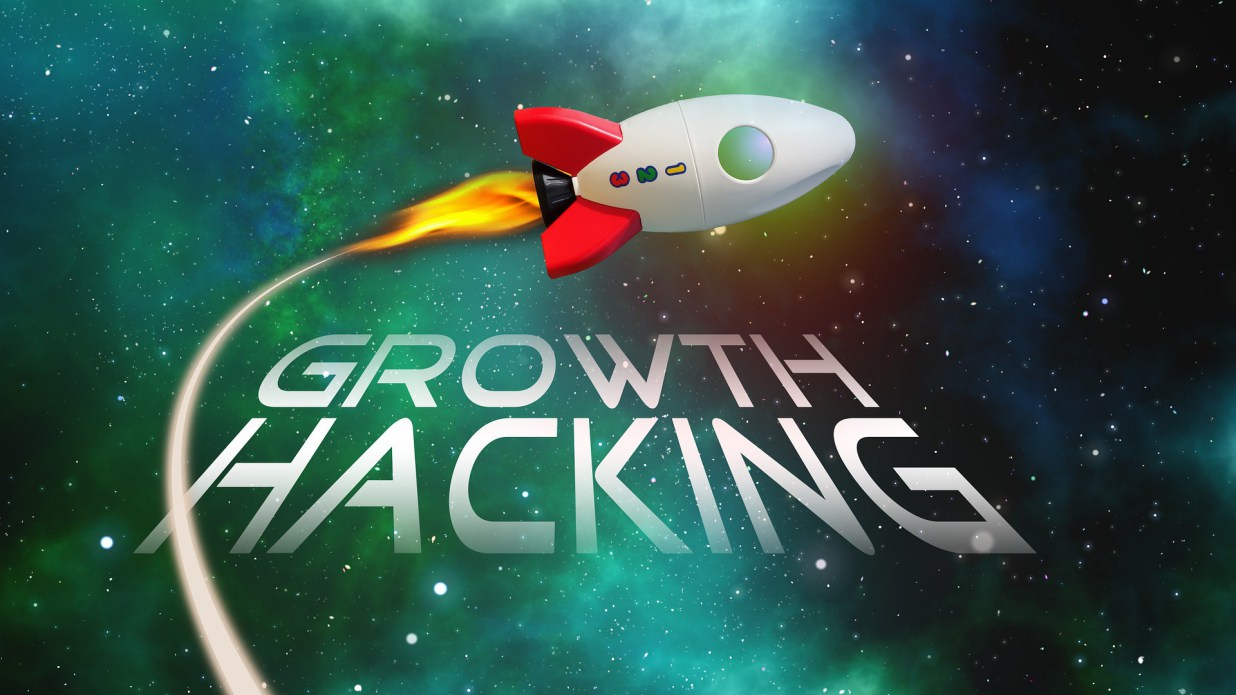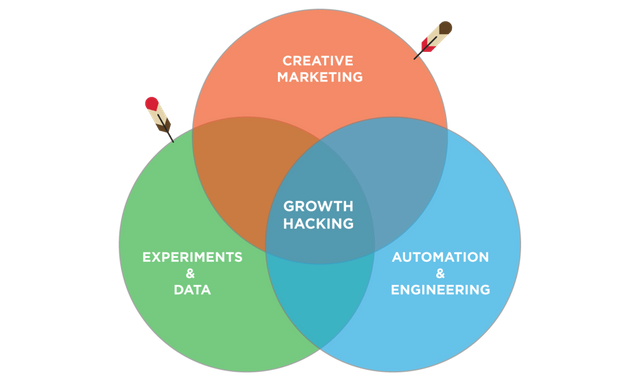The Best Free guide of Growth Hacking

Growth hacking put in place devices that are easy to test, analyze and develop on a large scale. Growth piracy is above all a state of mind. This is not a fixed technique. For those who are used to traditional marketing, it is imperative to change software.
Growth hacker is a new key role in startups

A growth hacker is an employee whose one and only goal is to grow the business. This role has become key to many startups and is gradually replacing the role of Marketing Director.
One of the first companies to have thought its growth strategy differently is Hotmail, the free mail manager. To make themselves known, Hotmail decides in 1996 to place a small message at the bottom of each email with marked “PS: I love you.” (PS: I love you, get a free email on Hotmail) . Each email became an advertisement for Hotmail and network effect, by the end of 1997 more than ten million people had registered.
Like any entrepreneurial initiative, the goal of the growth hacker is to acquire the maximum number of customers for the lowest possible cost or, in other words, to maximize return on investment (ROI).
For this, the growth hacker uses techniques specific to the digital world: emails, blogs, or APIs. Growth hackers have helped several companies like Snapchat, Evernote, Twitter or Dropbox to maximize their number of customers with a very limited budget. Gone are television campaigns that cost several hundred thousand euros, now the growth goes through more original techniques.
In addition, unlike traditional marketing, growth hacking must be integrated into the strategy from the design stage. It is no longer a question of creating a product, but of how to make it known to the wider public. In new digital companies, product design must incorporate delivery elements within the product or service.
A growth hacker is a skilled mix between a developer, a designer and a marketing specialist. Some have become well known as Noah Kagan who worked at Facebook then MInt.com or Sean Ellis at Dropbox.
Finding your “Product market fit” is an essential step to start a start-up
Before starting a start-up, an entrepreneur must verify that his product really meets a need for a well-targeted category of people, small or large. For growth hacking, there is Product Market Fit only if users find that the product exactly meets their needs.It is necessary to constantly test and ask for feedback on the product.
A product or service that has already been tested with its users is more likely to appeal to as many people as possible.
With today’s available IT tools, it’s very easy to ask users what they think of the product, which could be improved, or if they would recommend it to their friends.
A book written by an author alone for a year without ever showing his manuscript less likely to become a best-seller than a book written by an author who holds a blog where he could test ideas and ask his readers to comment his tickets .
Some unicorns like #Airbnb or #Instagram, now worth billions of dollars, had to examine their product before finding their right product.
When Airbnb was first created in 2007, it was called “Airbedandbreakfast” and featured an inflatable bed and a homemade breakfast in the loft of founders Brian Chesky and Joe Gebbia in San Francisco.
The company then positioned itself as an alternative to hotels for people attending major design conferences in San Francisco. Finally, the founders changed the name of the site to Airbnb and abandoned the idea of breakfast and the network side of the project.
Another example with Instagram which started as a geolocalized social network. The application called Burbn used to take pictures with filters.
The founders quickly saw that the users of the application were rushing to this feature. So they changed the name of their company to Instagram and repositioned their product: a mobile application to post photos with a filter. One week after this new launch, Instagram had 100,000 users.
For Marc Andreessen, the great American entrepreneur, notably the founder of Netscape and the Andreessen Horowitz fund, you absolutely have absolutely everything you need to access the product / market.
This may involve changing teams, reviewing their product, accessing another market, or diluting. The important thing is to face its market.
Increase the number of users with a very small marketing budget
Like any business, the start-up that found its Product Market Fit must then focus on growing its users. Growth hacking involves bringing as many people to the site as possible and converting them into customers.
But the way to attract these new customers differs from the traditional marketing strategy. The growth hacker must succeed to be effective, for little and if possible by a means never seen elsewhere.
The example of Dropbox shows how this company succeeded in making its debut without any significant advertising budget.
At the beginning, Dropbox was not even open to the public: new users had to register to be invited to use the online storage service. To increase the number of registered members, the founders themselves created a small video explaining their service. The success was immediate, so much so that Dropbox has created a dedicated web page dedicated to registration: www.GetDropbox.Com. The waiting list to register has gone from 5000 to 72000 users overnight.
The author proposes other examples of growth hacking allowing to significantly increase the number of clients such as:
– create hundreds of false user profiles to make believe that its service is extremely popular, such as Reddit;
– lean on a platform or site to benefit from its growth (PayPal with Ebay);
– be limited to a small market at the beginning and then deploy, as Facebook did by offering only its service to Harvard students before extending to all American universities and then to the world;
– organize a great event to get first-time users, such as Myspace or Yelp;
- bring in a known investor, more for his popularity than for his money.
Thinking about virality: a fundamental notion in the strategies put in place by growth hackers
Virality is essential in growth hacking. It is by this means that a product or service is made known by the greatest number, free of charge or at least at a much lower cost than a traditional advertising campaign.
Virality does not happen by accident, or in any case very exceptionally. You have to want to be viral so that its service or its product is shared by the greatest number. In order for a user to share a link or video on his Facebook page, he must have an interest in doing so. We must make him want to talk about him.
Couponing services like Groupon and Living Social have incorporated this concept of virality into their service. So, Groupon launched Operation “Sponsor a Friend” to earn $ 10 if a friend buys his first deal. Living Social offers a free deal if three other friends buy it too.
Word-of-mouth is now strongly encouraged and facilitated by digital use and especially social networks. With more than one hundred and fifty friends on Facebook, a post can increase the number of people affected. Spotify has developed thanks to its integration with Facebook which allows to see what its friends are listening to.
Dropbox also used the networks of its users to accelerate its growth by offering one hundred and fifty megabytes of storage for users connecting their account to Facebook or Twitter.
The company has also set up an effective sponsorship system by offering five hundred megabytes of additional space for each friend who enrolls in Dropbox (35% of new users arrive today thanks to this system).
Continuously improving its product to keep its customers
After attracting many users, the goal is to make them stay. They have to want to buy back the product or use the service. We must ensure that the customer is so satisfied that he wishes to return as often as possible.
Twitter has faced this problem. Many new users registered on the microblogging site, but few actually used it. To solve this problem, Twitter hired a growth hacker, Jack Elman, who recruited a team of twenty-five people. By analyzing the data, they realized that a user who selects five or ten people to follow on his first use had a greater chance of using Twitter regularly.
Jack Elman’s team then changed the suggestion of people to follow when registering by offering a large choice of people instead of the twenty that were previously offered by default. They also set up a permanent sidebar on the website that offers new people to follow.
Growth hacking is thus always at the frontier of product development and marketing.
Airbnb also enhanced the user experience on its site by offering the services of a professional photographer for free. This service has greatly improved the quality of the photos of the apartments put online and make the site more premium.
The growth hacker must always wonder how to improve his product to retain his customers. If growth slows, the growth hacker will not think of spending more money in marketing or marketing but to improve its product so that users come naturally.
Retaining customers is a key element of a company’s success. According to a study by consulting firm Bain & Company, a 5% increase in customer retention results in a 30% increase in profitability.
A concrete example of growth hacking in publishing
Ryan Holliday explains how he helped author Tim Ferris make his third book, The 4-Hour Chef. Tim Ferris is the author of the bestseller The 4-hour week, sold several million copies. The 4-Hour Chef has the distinction of having been published by Amazon.
All bookstores and major outlets such as Barnes & Nobles have refused to distribute it. How to make this book a bestseller without a physical distribution network?
Ryan Holliday explains that he has apprehended this problem with the state of mind of a growth hacker. You had to be creative and analytical. These are the main steps that have enabled the book to be very successful:
The product market fit
The Product Market Fit: the author tested several chapters of his book with his readers before arriving at the final version (about 200 of the original 800 pages were cut). The cover has also been shown to several readers in order to achieve a perfect harmony between the product and the potential readers.
Growing and Keeping Clients: To make the book speak, the author has preferred bloggers rather than traditional media.
With tools like Alexa, he was able to spot the number of visitors to blogs and to target which blogger to contact. He has also written on his own blog, which he has held for five years and which allows him to know well and analyze his readers.
Virality: a partnership with BitTorrent to offer a pack on the book (video, excerpts, interview) to the 170 million members allowed to multiply sales of the book. In addition to publicizing the book, BitTorrent was referring to an Amazon link with 40% off. Result: two million downloads of the pack and thousands of books sold.
Optimization and Retention: A study of the data was carried out by the author to understand what had worked, the most read blogs to capitalize the experience for his next books.
Conclusion

Growth hacking has become a new part of marketing. Imagined by entrepreneurs who are more creative and less wealthy than traditional companies, growth hacking has greatly improved ROI. It is above all a state of mind: it is about being creative, testing, analyzing the data and pursuing the optimization of the product almost eternally.
What should be borne in mind when reading this summary:
– growth hacking is a new key role in startups;
– finding its “Product market fit” is an essential step to start a startup;
– increase the number of users with a very limited marketing budget;
– think of virality: a fundamental notion in the strategies put in place by growth hackers;
– continually improve its product to keep its customer
Thanks for reading our article ! I Already love this platform!
Good!
Beautiful post
Nice post! I will follow you from now on. +UP
Congratulations @ztrategist! You received a personal award!
You can view your badges on your Steem Board and compare to others on the Steem Ranking
Vote for @Steemitboard as a witness to get one more award and increased upvotes!